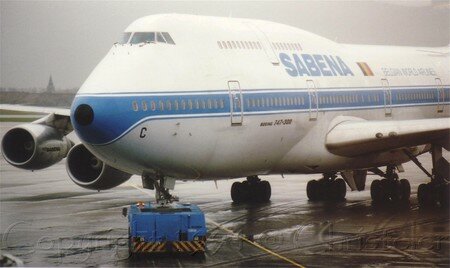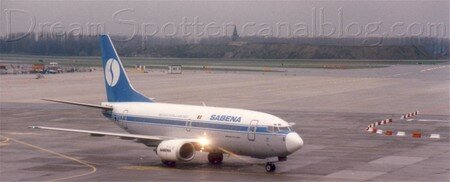Brussels, National (BRU/EBBR) Belgium - 1994
![]() DSp Pictures
DSp PicturesYear Minolta Spot location Film Scan 1994
Inside the terminal behind the windows
14 november 1994
History
The airport was constructed during World War II by the German occupying force. There is an urban legend that the site of the airport in Zaventem was chosen by the Germans after asking locals where to build it - the Belgians then pointed to this location as it was often foggy.
After the German occupation, the Belgian army took control of the airport. When the old civilian airport in Haren became too small, it was decided to use the site in Zaventem for the new national airport. By 1948, a new terminal building was constructed to replace the old wooden building.
Haren airport
In 1955, a train line connecting Brussels with the airport was constructed. A direct train link with Leuven and Liège was opened on December 12, 2005. A link with Antwerp will be completed in 2010. In April 1957, construction started of the new terminal, preparing the airport for the 1958 World Fair. During the boom of commercial aviation in the 1960's and 1970's, several hangars were constructed. A new cargo terminal was constructed in 1976. In 1994, a brand new terminal was constructed adjacent to the old 1958 building. Two old piers were torn down and replaced by modern ones. In 2002, amidst the turmoil engulfing the demise of the national airline Sabena, a new pier was opened. This Pier A is destined to support flights from and to the Schengen treaty countries.
The origins of Brussels Airport at Zaventem date back to 1940, when the German occupying force laid claim to 600 ha (1,500 acres) of agricultural fields to the east of Brussels, near the Belgian military back-up airfield "Steenokkerzeel". The Germans constructed 3 runways in the shape of a triangle: runway 02/20 and 07L/25R which are still in use today, and runway 12/30. The airfield buildings however were constructed within the territory of the nearby municipality of Melsbroek and not of Zaventem, which is why the airfield was known to the locals as the airfield of Melsbroek, or "Fliegerhorst Melsbroek" to the Germans. There is an urban legend that the site of the airport was chosen by the Germans after asking locals where to build it - the Belgians then pointed to this location as it was often foggy.
After the liberation (3 September 1944), the German infrastructure at Melsbroek fell into the hands of the British. When the old civilian airport in Haren became too small, the Belgian authorities decided to use the aerodrome at Melsbroek for the new national airport. By 1948, a new terminal building was constructed to replace the old wooden building. In the same year, the length of both runways 02/20 and 07L/25R were increased to 1,200 m (3,900 ft) and 2,450 m (8,000 ft) respectively, whereas 12/30 remained at 1,300 m (4,300 ft). The civil aerodrome of Melsbroek was officially opened by Prince Charles, Count of Flanders, the Prince Regent on 20 July 1948. From 1948 to 1956 many more buildings and facilities were erected, but almost always on the Melsbroek side of the site.
In 1955, a train line connecting the city centre of Brussels with the airport was constructed. The line was officially opened by King Baudouin on 15 May 1955. A direct train link with Leuven and Liège was opened on 12 December 12 2005.
In 1956 a new 2,300 m (7,500 ft) runway was constructed, the 07R/25L which runs parallel with 07L/25R. The runway is still in use today and saw its length later increased to 3,200 m (10,000 ft). In April 1956 the Belgian government decided to build a new airport, using the same runways, but with the buildings located within the territory of the municipality of Zaventem. In April 1957, construction started of the new terminal, preparing the airport for the 1958 World Fair. The grass runway 12/30 had to make way to allow for the new passenger terminal. This new airport was inaugurated 5 July 1958, almost just in time for the 1958 World Fair. So historically, the birth date of Zaventem Airport is 5 July 1958. Incidentally, the buildings on the Melsbroek side are still in use by the Belgian Air Force (15th Air Transport Wing), and is still known as Melsbroek airfield. Both Zaventem Airport and Melsbroek Air Base, the military airfield, share the same runways.
During the boom of commercial aviation in the 1960s and 1970s, several hangars were constructed. A new cargo terminal was constructed in 1976. In 1994, a brand new terminal was constructed adjacent to the old 1958 building. Two old piers were torn down and replaced by modern ones. In 2002, amidst the turmoil engulfing the demise of the national airline Sabena, a new pier was opened. This Pier A is destined to support flights from and to the Schengen treaty countries and supports since the 15th of October 2008 all flights to African destinions (at the T-gates).
The airport is operated by The Brussels Airport Company, owned by the Australian group MAp Airports (75%) and the Belgian State (25%). The company president is Luc Van den Bossche (former Belgian government minister). The position of CEO is currently vacant.
Brussels airport currently consists of 54 contact gates, and a total of 109 gates.
In 2007, the airport served 17.8 million passengers, an increase of 7% over 2006. The cargo volume in the same year amounted to 780,000 tonnes, an increase of 8.9% over 2006. In 2008, the airport served 18,5 million passengers, which was an increase of 3,7% over the previous year.
Sabena's demise meant a sharp fall in passenger traffic, a blow the airport only slowly recovered from. The airport's future is threatened by disagreement between the governments of Flanders and the Brussels Capital Region concerning nocturnal air traffic routes.
Brussels Airport is operated by The Brussels Airport Company, formerly known as BIAC (Brussels International Airport Company), which was created by Belgian law through a merger of BATC with the ground operations departments of the RLW/RVA.
The construction of a new low-cost airlines pier is currently on hold. It will be built roughly where the old south pier used to be. At present, several low-cost airlines including Ryanair and Wizz Air fly to "Brussels South Airport", actually located in Charleroi, 40 km (25 mi) away from Brussels.
In March 2009, the old mechanical Flight information display system were replaced by electronic ones.
In September 2009, CEO Wilfried Van Assche resigned. One of the (unofficial) reasons is the delay of the construction of the lowcostterminal and the possible lawsuit by 52 airlines active at Brussels Airport, because of the tax-discrimination.


/https%3A%2F%2Fprofilepics.canalblog.com%2Fprofilepics%2F8%2F1%2F81057.jpg)
/https%3A%2F%2Fstorage.canalblog.com%2F20%2F39%2F97146%2F32300127_o.jpg)
/https%3A%2F%2Fstorage.canalblog.com%2F12%2F78%2F97146%2F30672854_o.jpg)
/https%3A%2F%2Fstorage.canalblog.com%2F26%2F90%2F97146%2F27985019_o.jpg)
/https%3A%2F%2Fstorage.canalblog.com%2F37%2F46%2F97146%2F27230276_o.jpg)
/https%3A%2F%2Fstorage.canalblog.com%2F33%2F59%2F97146%2F21981067_o.jpg)










































/http%3A%2F%2Fstorage.canalblog.com%2F07%2F43%2F97146%2F19606288_o.png)
/http%3A%2F%2Fstorage.canalblog.com%2F73%2F44%2F97146%2F13866477_o.png)
/http%3A%2F%2Fstorage.canalblog.com%2F34%2F09%2F97146%2F28013844.gif)
/http%3A%2F%2Fstorage.canalblog.com%2F61%2F49%2F97146%2F56317899_o.jpg)